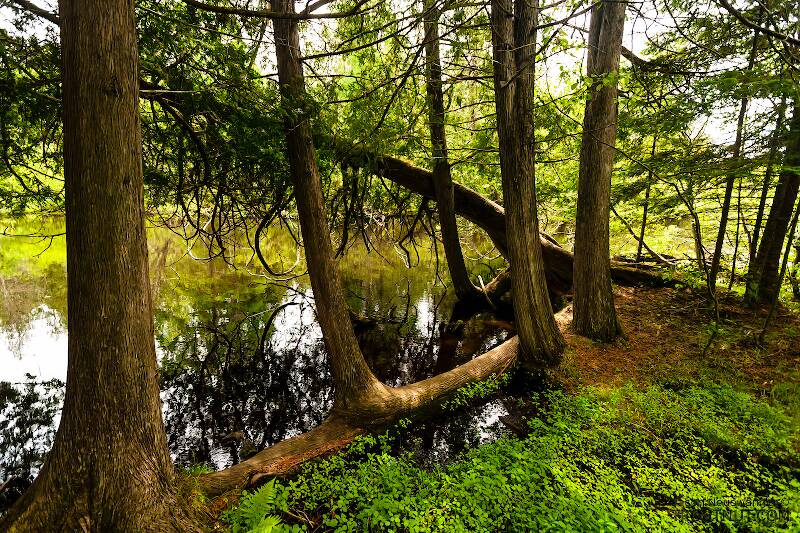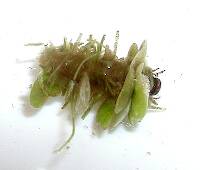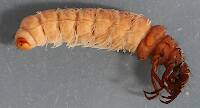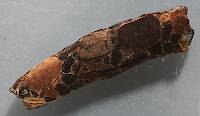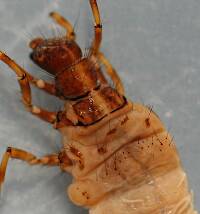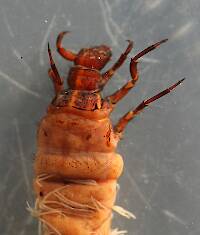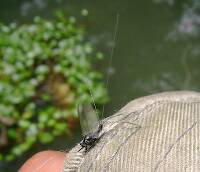
Salmonflies
Pteronarcys californica
The giant Salmonflies of the Western mountains are legendary for their proclivity to elicit consistent dry-fly action and ferocious strikes.
Featured on the forum

This species was fairly abundant in a February sample of the upper Yakima.

Troutnut is a project started in 2003 by salmonid ecologist Jason "Troutnut" Neuswanger to help anglers and
fly tyers unabashedly embrace the entomological side of the sport. Learn more about Troutnut or
support the project for an enhanced experience here.
Troutnabout
Posts: 20
Posts: 20
Troutnabout on Nov 27, 2006November 27th, 2006, 4:52 pm EST
can anyone identify this caddisfly and the green leaves used in the home construction?
Troutnabout
Posts: 20
Posts: 20
Troutnabout on Nov 27, 2006November 27th, 2006, 4:59 pm EST
Sorry about my last post. I couldn't figure out how to add a picture attachment. The original photograph is at flyfishing entemology.com. the pictue is titled caddis home.
Taxon on Nov 27, 2006November 27th, 2006, 5:14 pm EST
Sorry about my last post. I couldn't figure out how to add a picture attachment. The original photograph is at flyfishing entemology.com. the pictue is titled caddis home.
Troutabout-
If you are referring to FlyfishingEntomology.com, I'm not aware of any file titled caddis home on my site. However, I did Google/Images "caddis home" and found the following photo from Michelle Mahood's gallery: http://www.pbase.com/michellemahood/image/24877105
Is that the photo?
Troutnabout
Posts: 20
Posts: 20
Troutnabout on Nov 27, 2006November 27th, 2006, 5:33 pm EST
roger that's it. sorry about the incomplete info.
Taxon on Nov 27, 2006November 27th, 2006, 5:51 pm EST
Troutabout-
No problem. I would guess the photo is of a cased Platycentropus larva. As to which species of leaf was used in construction of the case, that question will need be answered by someone else.
No problem. I would guess the photo is of a cased Platycentropus larva. As to which species of leaf was used in construction of the case, that question will need be answered by someone else.
Troutnabout
Posts: 20
Posts: 20
Troutnabout on Nov 27, 2006November 27th, 2006, 6:00 pm EST
Roger:you are the man! Thanks for your timely responses. I entered a fly swap challege and was given green artificial lei flowers,tan jute and some black yarn to tie with. I just tied two of them and wanted to know what they imitated. Is this a common species? Where in the US are they found besides CA ?
Troutnut on Nov 27, 2006November 27th, 2006, 6:06 pm EST
FYI I just moved this topic to the Platycentropus comments based on Roger's ID guess. :)
Jason Neuswanger, Ph.D.
Troutnut and salmonid ecologist
Troutnut and salmonid ecologist
Taxon on Nov 27, 2006November 27th, 2006, 6:30 pm EST
Roger:you are the man!
Troutabout-
Well, that stands to be seen. There are others on this site who know much more about caddisflies than do I. As to where they are found, to the best of my knowledge, only in the East and Midwest, where "they are able to thrive in a in a wide variety of habitats, including stillwaters and warmwaters" per Gary LaFontaine.
Litobrancha on Dec 5, 2006December 5th, 2006, 4:28 am EST
Schmid lists Platycentropus radiatus from Nova Scotia to Manitoba, my records also include AL GA NC SC TN VA northward. don't have records on P. amicus or P. indistinctus but Schmid lists amicus from Quebec to Alberta and indistinctus from Newfoundland to Ontario. all three are as others have said are distributed in the eastern half of the continent so I'll chime and say I bet that ain't Platycentropus from CA. but the prosternal horn character is the one to look for.
Entoman on Oct 16, 2012October 16th, 2012, 12:01 pm EDT
Ah! Luckily the link to the photo is still good. This looks like a turret-cased species of Lepidostoma to me.
"It's not that I find fishing so important, it's just that I find all other endeavors of Man equally unimportant... And not nearly as much fun!" Robert Traver, Anatomy of a Fisherman
Creno on Oct 17, 2012October 17th, 2012, 7:33 am EDT
I suspect this is an early instar of Limnephilus. I will go out on a limb and say less than 2cm long, perhaps about 1cm. The "large" round "leaves" appear to me to be one of the duckweeds and the threads appear to be filamentous algae. The dark anterior band of the prothorax, which is very distinct in the photo, is characteristic of a couple of the pond Limnephilus species. One of those is the common, widespread Limnephilus externus. I have seen early instar Limnephilus externus with cases just like this in Colorado ponds/reservoirs. Often, because the duckweeds are designed to float, the small case is just floating around in the surface film with the larvae flailing its legs around trying to grab onto something. I wonder if the advantage of such case material choice is dispersal or perhaps they just eat house and home. In any case L. externus does it alot and I suspect others in that group do as well.
There is another picture on Michelle's page with the larvae extended further from the case. That is a very immature larvae, likely 2nd instar, and sclerite coloration does not appear to have fully developed it. Perhaps recently molted?
There is another picture on Michelle's page with the larvae extended further from the case. That is a very immature larvae, likely 2nd instar, and sclerite coloration does not appear to have fully developed it. Perhaps recently molted?
Entoman on Oct 18, 2012October 18th, 2012, 9:48 am EDT
Dave -
Well, hopefully it's not as flimsy as the one I fell off of.:) I didn't think of an early instar limnephilid, but certainly bow to your expertise. Interesting comments on the drift behavior. I've noticed the same thing, and not just with caddis. Reflects the precarious nature of living a neutral buoyancy life in the weeds, I guess. Wind action - currents caused by turnover - release of their perches to escape predation (or knocked off them by competitors)? I'm thinking these can all be causes as well?
I will go out on a limb...
Well, hopefully it's not as flimsy as the one I fell off of.:) I didn't think of an early instar limnephilid, but certainly bow to your expertise. Interesting comments on the drift behavior. I've noticed the same thing, and not just with caddis. Reflects the precarious nature of living a neutral buoyancy life in the weeds, I guess. Wind action - currents caused by turnover - release of their perches to escape predation (or knocked off them by competitors)? I'm thinking these can all be causes as well?
"It's not that I find fishing so important, it's just that I find all other endeavors of Man equally unimportant... And not nearly as much fun!" Robert Traver, Anatomy of a Fisherman
Quick Reply
Related Discussions
Topic
Replies
Last Reply
0
Sep 23, 2006
by Litobrancha
by Litobrancha
0
Sep 23, 2006
by Litobrancha
by Litobrancha

